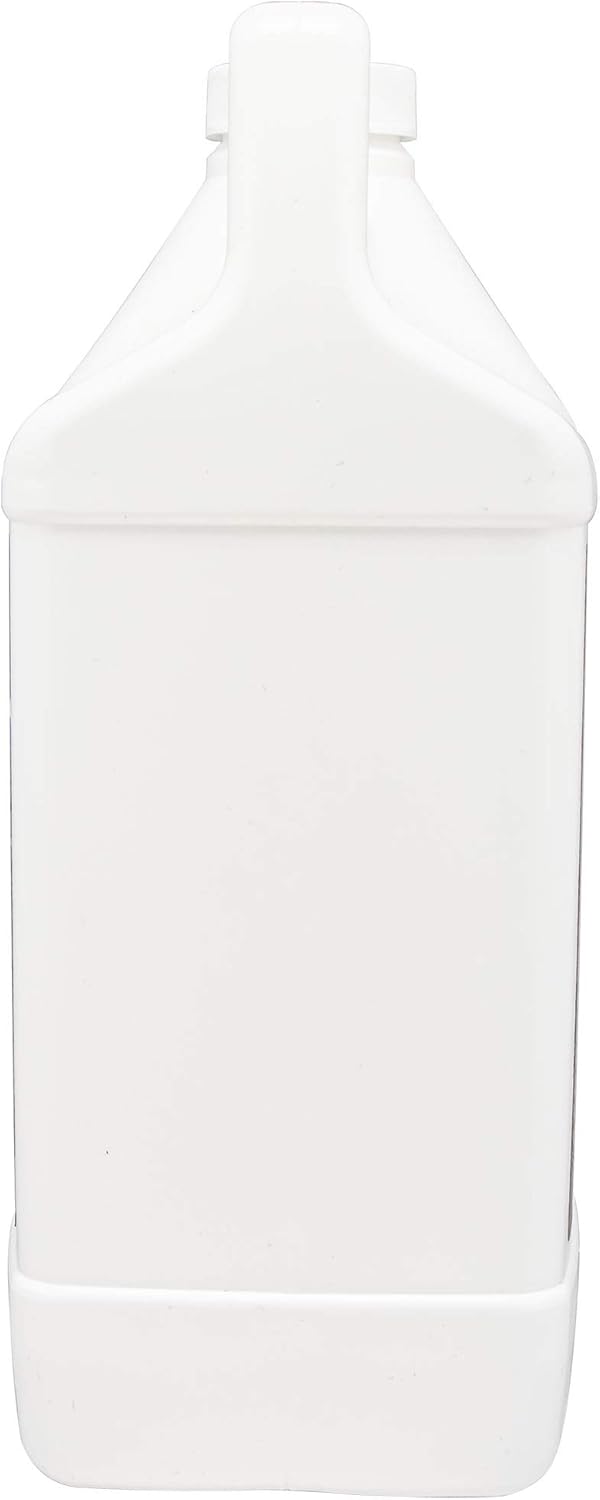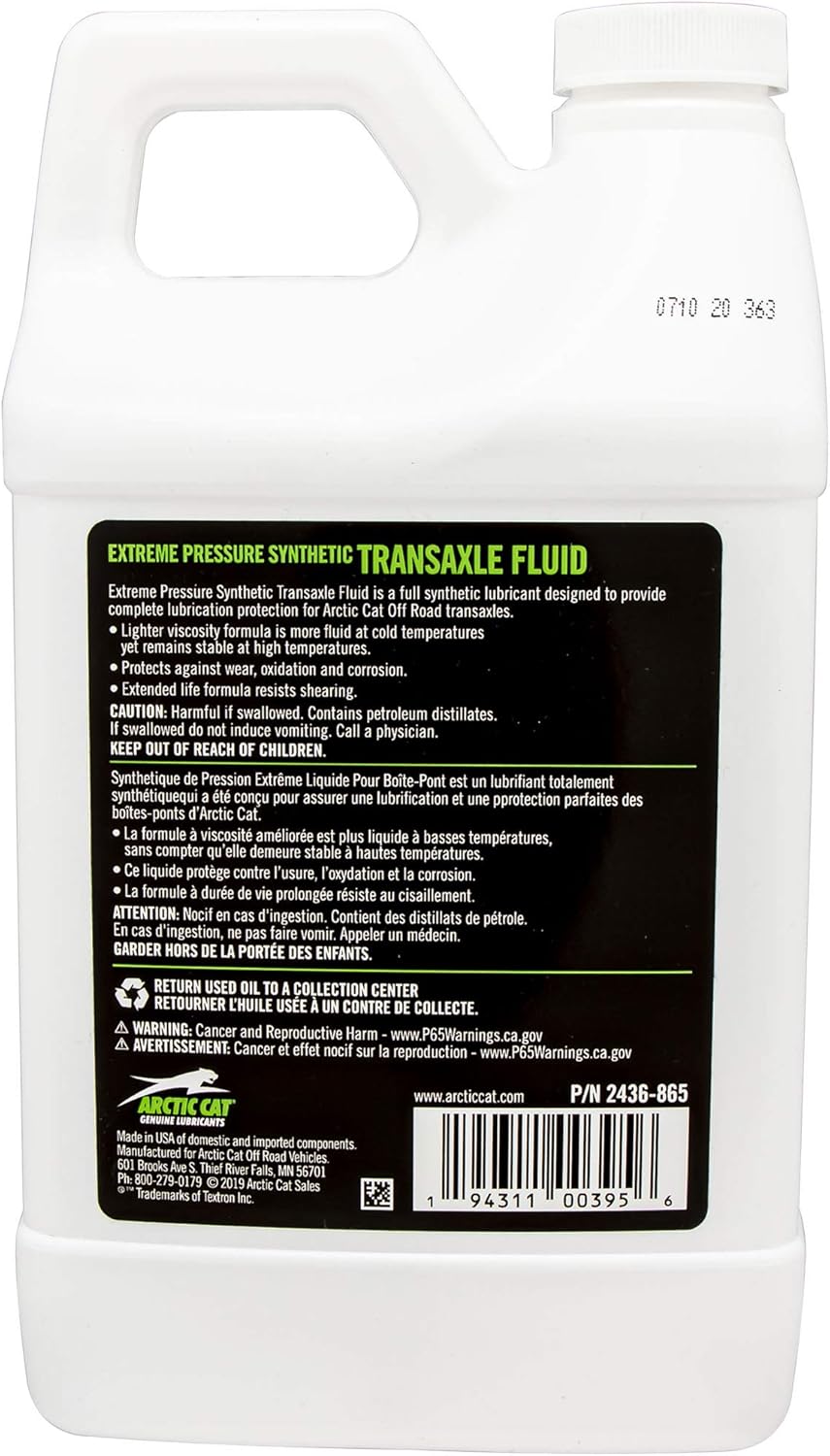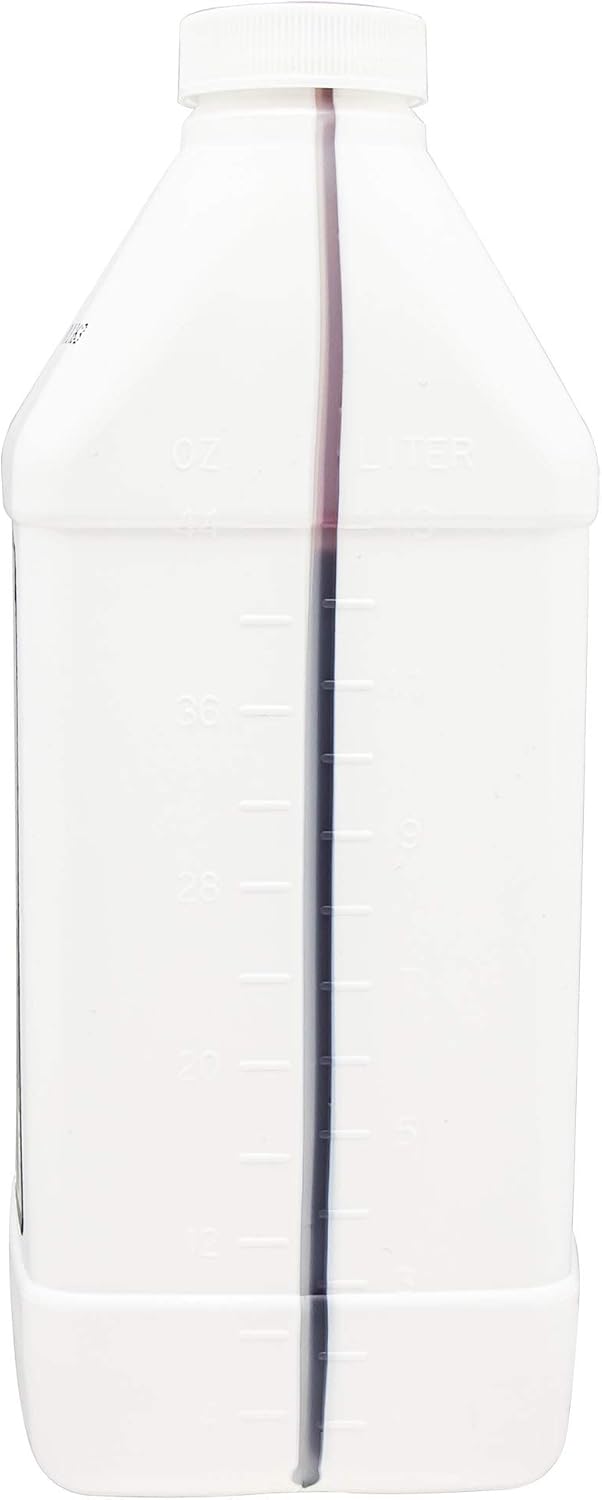
2436-865 Arctic Cat Synthetic Transaxle Review transaxle fluid – Oemiu
2436-865 Arctic Cat Synthetic Transaxle Fluid Review
Maintaining your Arctic Cat ATV or UTV’s transaxle is crucial for ensuring its longevity and optimal performance. The transaxle, a combination of transmission and axle, endures significant stress during off-road adventures, making proper lubrication absolutely vital. Among the various transaxle fluids available, the Arctic Cat Synthetic Transaxle Fluid, specifically the 2436-865 formulation, stands out. But is it worth the investment? This in-depth review will dissect its features, benefits, and potential drawbacks to help you make an informed decision.
Understanding the Importance of Transaxle Fluid
The transaxle, often the unsung hero of your ATV or UTV, plays a critical role in transferring power from the engine to the wheels. It’s a complex system of gears, bearings, and shafts constantly working under immense pressure, heat, and friction. Without proper lubrication, these components will rapidly wear down, leading to costly repairs or even complete transaxle failure. The transaxle fluid acts as a vital coolant, lubricant, and protectant. It reduces friction between moving parts, dissipates heat generated during operation, and prevents corrosion and rust from forming inside the transaxle housing. Choosing the right transaxle fluid, and adhering to the recommended maintenance schedule, is not merely a suggestion; it’s a necessity for extending the life and performance of your Arctic Cat machine. Think of it like the oil in your engine – neglecting it has serious consequences. A high-quality fluid like a synthetic transaxle lubricant provides superior protection, especially under the demanding conditions often encountered while off-roading.
Different types of transaxle fluids exist, ranging from mineral-based to synthetic blends to full synthetics. Mineral-based fluids are generally the most affordable but offer the least protection against extreme temperatures and wear. Synthetic blends offer a compromise between price and performance, while full synthetic fluids provide the highest level of protection and are designed for demanding applications. The Arctic Cat 2436-865 is a full synthetic, formulated specifically for the unique demands of Arctic Cat ATVs and UTVs. This formulation is designed to withstand extreme temperatures, both hot and cold, and resist breakdown under high stress. The goal is to maintain consistent viscosity and lubrication properties over extended periods, even when subjected to heavy loads and challenging terrains. This provides peace of mind knowing your transaxle is protected, no matter the conditions. Using the right synthetic transaxle fluid can prevent premature wear.
Delving into the 2436-865 Arctic Cat Synthetic Formulation
The 2436-865 Arctic Cat Synthetic Transaxle Fluid isn’t just another lubricant; it’s a carefully engineered formulation designed to meet the specific needs of Arctic Cat transaxles. Its synthetic base provides exceptional thermal stability, allowing it to perform consistently across a wide temperature range. This is particularly important in regions with extreme weather conditions or when pushing your machine to its limits during intense riding sessions. Beyond temperature stability, the synthetic base offers superior resistance to oxidation and breakdown compared to mineral-based fluids. Oxidation can lead to the formation of sludge and varnish, which can clog internal passages and reduce lubrication effectiveness. The 2436-865 formulation minimizes this risk, ensuring optimal performance and extending the fluid’s service life. Furthermore, the fluid is formulated with advanced additives that provide enhanced wear protection for gears, bearings, and other critical components. These additives create a protective film on metal surfaces, reducing friction and wear, even under high loads and shock conditions. This is especially beneficial for riders who frequently tow heavy loads or navigate challenging terrain. The composition of a quality transaxle lubricant makes a big difference. The proper synthetic transaxle lubricant will perform better than conventional oils.
Another key aspect of the 2436-865 formulation is its compatibility with seals and gaskets. Some aftermarket fluids can cause seals to swell or shrink, leading to leaks and potential damage to the transaxle. The Arctic Cat fluid is specifically formulated to be compatible with the materials used in Arctic Cat transaxles, ensuring a tight seal and preventing leaks. This is a crucial consideration, as leaks can lead to fluid loss, reduced lubrication, and ultimately, transaxle failure. Furthermore, the fluid’s anti-foaming properties help to prevent air bubbles from forming, which can reduce lubrication effectiveness and cause cavitation damage. This is particularly important in high-speed applications where the fluid is subjected to agitation. By minimizing foaming, the 2436-865 fluid ensures consistent and reliable lubrication under all operating conditions. Ultimately, the 2436-865 Arctic Cat Synthetic Transaxle Fluid is a comprehensive solution designed to protect your transaxle from wear, corrosion, and breakdown, ensuring optimal performance and extending its service life. The benefits of using a premium synthetic transaxle fluid are significant, leading to longer transaxle life and reduced maintenance costs in the long run. Regular transaxle fluid changes with the correct type are crucial for maintaining optimal performance.
Real-World Performance and User Experiences
While technical specifications are important, real-world performance and user experiences provide valuable insights into the effectiveness of the 2436-865 Arctic Cat Synthetic Transaxle Fluid. Many users report noticeable improvements in transaxle performance after switching to this fluid. These improvements often include smoother shifting, reduced noise, and improved overall responsiveness. Some users have even reported a reduction in operating temperature, indicating improved cooling efficiency. This is particularly noticeable in machines that are frequently used for towing or heavy-duty applications. A common theme among user reviews is the increased confidence in the reliability of their machines after switching to the Arctic Cat synthetic fluid. Knowing that their transaxle is protected by a high-quality lubricant provides peace of mind, especially when venturing into remote or challenging terrain. Users often mention the extended service life of the fluid, allowing them to go longer between fluid changes compared to using conventional fluids. This can save time and money in the long run, making the initial investment in the synthetic fluid worthwhile. The extended drain intervals offered by synthetic transaxle fluid mean less frequent maintenance. The right transaxle lubricant is key for longevity.
However, it’s important to acknowledge that some users may not notice a significant difference in performance after switching to the 2436-865 fluid. This is often the case if the machine is already well-maintained and operating under relatively mild conditions. In such cases, the benefits of the synthetic fluid may be more subtle, such as improved wear protection and extended service life. It’s also worth noting that some users may experience a slight increase in cost compared to using conventional fluids. However, this cost is often offset by the extended service life and potential for reduced maintenance costs in the long run. Ultimately, the decision to switch to the 2436-865 Arctic Cat Synthetic Transaxle Fluid depends on individual needs and priorities. If you value optimal performance, enhanced protection, and extended service life, the synthetic fluid is likely a worthwhile investment. However, if you are primarily concerned with cost and operate your machine under relatively mild conditions, a conventional fluid may be sufficient. Regardless of the fluid you choose, it’s essential to adhere to the recommended maintenance schedule and use a fluid that meets the specifications outlined in your owner’s manual. The correct type of transaxle fluid is essential for keeping your vehicle in top condition.
Pros and Cons of Using 2436-865 Arctic Cat Synthetic Transaxle Fluid
To provide a balanced perspective, let’s summarize the pros and cons of using the 2436-865 Arctic Cat Synthetic Transaxle Fluid:
| Pros | Cons |
|---|---|
|
|
As you can see, the pros generally outweigh the cons, especially for riders who demand optimal performance and reliability from their machines. The higher initial cost is often offset by the extended service life and potential for reduced maintenance costs in the long run. However, it’s important to consider your individual needs and priorities before making a decision. If you’re on a tight budget and operate your machine under relatively mild conditions, a conventional fluid may be sufficient. But if you’re a serious off-roader who demands the best possible protection for your transaxle, the 2436-865 Arctic Cat Synthetic Transaxle Fluid is a worthwhile investment. The key is to choose a fluid that meets the specifications outlined in your owner’s manual and to adhere to the recommended maintenance schedule. It is important to use the correct synthetic transaxle oil.
Alternatives and Comparisons: Exploring Other Options
While the 2436-865 Arctic Cat Synthetic Transaxle Fluid is a popular choice for Arctic Cat owners, it’s important to consider alternative options to ensure you’re making the best decision for your specific needs. Several aftermarket fluids are available that claim to offer comparable performance and protection. These fluids often come at a lower price point, making them attractive to budget-conscious consumers. However, it’s crucial to carefully evaluate the specifications and reviews of these aftermarket fluids before making a purchase. Some aftermarket fluids may not meet the same standards as the Arctic Cat fluid, potentially leading to reduced performance or even damage to your transaxle. When considering alternatives, pay close attention to the fluid’s viscosity, thermal stability, and compatibility with seals and gaskets. Look for fluids that meet or exceed the specifications outlined in your owner’s manual. It’s also helpful to read user reviews to get a sense of the fluid’s real-world performance and reliability. The correct type of synthetic transaxle oil will keep your vehicle running smoothly.
One popular alternative is Amsoil Synthetic ATV/UTV Transmission Fluid. Amsoil is a well-respected brand in the lubrication industry, and their ATV/UTV transmission fluid is known for its excellent wear protection and thermal stability. However, it’s important to verify that the Amsoil fluid is compatible with your specific Arctic Cat model before using it. Another alternative is Lucas Oil Synthetic ATV/UTV Transmission Fluid. Lucas Oil is another reputable brand known for its high-performance lubricants. Their ATV/UTV transmission fluid is designed to withstand extreme conditions and provide superior wear protection. Again, it’s important to verify compatibility before using it. When comparing different transaxle fluids, consider the following factors:
- Viscosity: The viscosity of the fluid determines its thickness and its ability to lubricate moving parts. Use a fluid with the viscosity recommended in your owner’s manual.
- Thermal stability: The fluid’s thermal stability determines its ability to maintain its viscosity and lubrication properties at high temperatures. Choose a fluid with good thermal stability, especially if you operate your machine in extreme conditions.
- Seal compatibility: The fluid’s compatibility with seals and gaskets is crucial for preventing leaks. Choose a fluid that is specifically designed to be compatible with the materials used in your transaxle.
- Additives: The fluid’s additives provide enhanced wear protection, corrosion resistance, and other benefits. Look for fluids with a comprehensive additive package.
- Price: Consider the price of the fluid relative to its performance and features. A more expensive fluid may be worth the investment if it provides superior protection and extends the life of your transaxle.
Ultimately, the best transaxle fluid for your Arctic Cat depends on your specific needs and priorities. By carefully evaluating the available options and considering the factors outlined above, you can make an informed decision and choose a fluid that will provide optimal performance and protection for your machine. Always check the specifications before using any transaxle fluid. Choosing the wrong one can result in costly damage. The right synthetic transaxle lubricant is imperative for vehicle reliability.
Frequently Asked Questions
What is the purpose of transaxle fluid?
Transaxle fluid serves several crucial purposes within your ATV or UTV’s transaxle. Primarily, it acts as a lubricant, reducing friction between the numerous moving parts, such as gears, bearings, and shafts. This minimizes wear and tear, extending the life of these components. Secondly, the fluid dissipates heat generated by friction, preventing overheating and potential damage. Think of it like the cooling system for your engine, but specifically for the transaxle. The fluid also protects against corrosion and rust by creating a barrier between metal surfaces and moisture. Furthermore, it helps to remove contaminants and debris from the transaxle, keeping the internal components clean. Finally, the correct fluid helps ensure smooth shifting and optimal power transfer. Using the correct synthetic transaxle fluid is paramount for proper operation.
How often should I change my transaxle fluid?
The frequency of transaxle fluid changes depends on several factors, including the type of fluid used, the operating conditions, and the manufacturer’s recommendations. As a general rule, it’s recommended to change your transaxle fluid every 100 hours of operation or every year, whichever comes first. However, if you frequently operate your machine in harsh conditions, such as mud, water, or extreme temperatures, you may need to change the fluid more frequently. Always consult your owner’s manual for the specific recommendations for your Arctic Cat model. Regularly checking the fluid level and condition is also a good practice. If the fluid appears dirty, discolored, or smells burnt, it’s time for a change, regardless of the recommended interval. Regular transaxle fluid changes are crucial for maintaining optimal performance and extending the life of your transaxle. Consider using a high-quality synthetic transaxle fluid to extend the change interval.
What type of transaxle fluid should I use in my Arctic Cat?
The best type of transaxle fluid for your Arctic Cat is the one recommended in your owner’s manual. Arctic Cat typically recommends using their 2436-865 Synthetic Transaxle Fluid, which is specifically formulated for their machines. However, you can also use a comparable aftermarket fluid that meets the specifications outlined in your owner’s manual. When choosing an aftermarket fluid, pay close attention to the viscosity, thermal stability, and seal compatibility. Ensure that the fluid is specifically designed for use in ATVs and UTVs. Using the wrong type of fluid can lead to reduced performance, damage to your transaxle, and even void your warranty. Always prioritize using a fluid that meets the manufacturer’s specifications, even if it costs a bit more. Using the wrong transaxle fluid can cause premature wear.
Is synthetic transaxle fluid better than conventional fluid?
Generally, synthetic transaxle fluid offers several advantages over conventional fluid. Synthetic fluids have superior thermal stability, meaning they can maintain their viscosity and lubrication properties at higher temperatures. This is particularly important for machines that are operated under heavy loads or in extreme conditions. Synthetic fluids also offer better wear protection, resistance to oxidation and breakdown, and extended service life. While synthetic fluids typically cost more than conventional fluids, the benefits often outweigh the cost, especially for riders who demand optimal performance and reliability from their machines. However, for machines that are operated under mild conditions, a conventional fluid may be sufficient. Always consult your owner’s manual for the recommended type of fluid. The extra cost of synthetic transaxle fluid can be worth it for extended vehicle life.
Can I mix different brands of transaxle fluid?
While it’s generally not recommended to mix different brands of transaxle fluid, it’s often unavoidable in emergency situations. If you must mix fluids, ensure that both fluids are compatible with your machine and meet the specifications outlined in your owner’s manual. It’s also advisable to use the same type of fluid (e.g., synthetic or conventional) when mixing. After mixing fluids, it’s recommended to change the fluid as soon as possible to avoid any potential compatibility issues. Mixing different brands of fluid can sometimes lead to reduced performance or even damage to your transaxle, so it’s best to avoid it if possible. It is better to drain and replace with the recommended fluid as soon as possible after mixing fluids. If your only option is to mix transaxle fluids, be sure to use the correct type of transaxle fluid.
What are the signs of bad transaxle fluid?
Several signs can indicate that your transaxle fluid is bad and needs to be changed. One common sign is difficulty shifting gears, particularly if the shifting feels rough or jerky. Another sign is unusual noises coming from the transaxle, such as whining or grinding sounds. You may also notice a reduction in power or overall performance. A visual inspection of the fluid can also reveal problems. If the fluid is dark, discolored, or smells burnt, it’s likely contaminated and needs to be changed. You may also notice sludge or varnish deposits in the fluid, which indicates oxidation and breakdown. Regularly checking the fluid level and condition can help you identify problems early on and prevent more serious damage to your transaxle. If you notice any of these signs, it’s best to change the fluid as soon as possible. Regular maintenance with the right synthetic transaxle fluid is crucial.
Where can I purchase 2436-865 Arctic Cat Synthetic Transaxle Fluid?
You can purchase the 2436-865 Arctic Cat Synthetic Transaxle Fluid from various sources, including authorized Arctic Cat dealers, online retailers, and some auto parts stores. Check the Arctic Cat website for a list of authorized dealers in your area. Many online retailers, such as Seller and eBay, also sell the fluid. However, it’s important to ensure that you’re purchasing from a reputable source to avoid counterfeit or substandard products. Before making a purchase, compare prices from different sources to ensure you’re getting the best deal. Also, check the expiration date of the fluid to ensure it’s still fresh. Purchasing the correct fluid from a trustworthy seller helps ensure your vehicle’s longevity. Always check reviews of vendors before buying fluids online.









